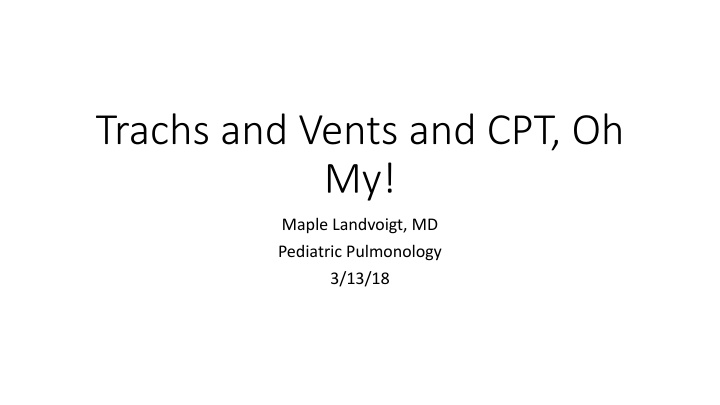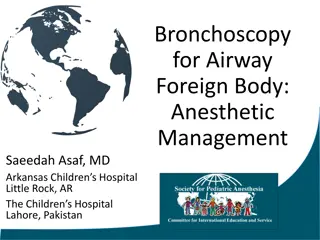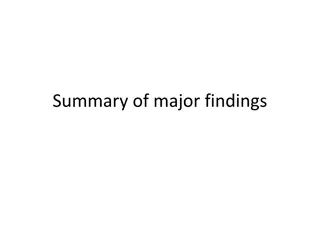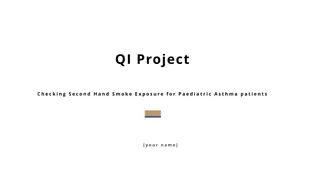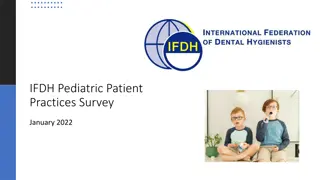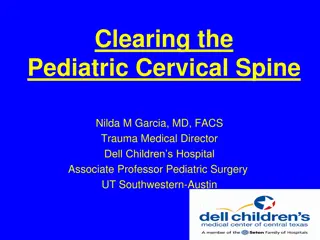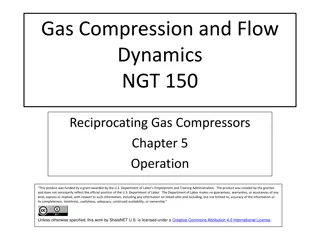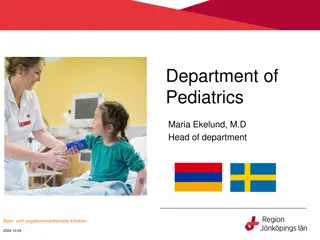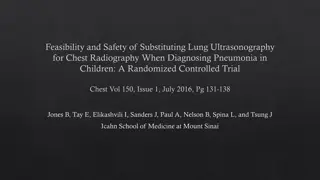Airway Clearance Techniques for Pediatric Patients with Special Healthcare Needs
Explore the strategies and technologies used to assist children with impaired airway clearance, including tracheostomy care, mechanical ventilator support, and supplemental airway clearance activities such as chest physiotherapy and oral care.
Download Presentation

Please find below an Image/Link to download the presentation.
The content on the website is provided AS IS for your information and personal use only. It may not be sold, licensed, or shared on other websites without obtaining consent from the author.If you encounter any issues during the download, it is possible that the publisher has removed the file from their server.
You are allowed to download the files provided on this website for personal or commercial use, subject to the condition that they are used lawfully. All files are the property of their respective owners.
The content on the website is provided AS IS for your information and personal use only. It may not be sold, licensed, or shared on other websites without obtaining consent from the author.
E N D
Presentation Transcript
Trachs and Vents and CPT, Oh My! Maple Landvoigt, MD Pediatric Pulmonology 3/13/18
Disclosures I have no actual or potential conflict of interest in relation to this program/presentation. I have no financial relationships to disclose.
Objectives 1.Recognize children with special healthcare needs at risk for respiratory failure 2.Classify common reasons for and complications of tracheostomy 3.Describe the medical care of children with mechanical ventilators in school 4.Discuss common chronic illnesses in children that would benefit from airway clearance assistance 5.Review supplemental airway clearance techniques and devices
Normal Airway Clearance The body has 2 ways to move things out of the airway: 1. Cough I. II. III. Expiration at high flow rates Inspiration to expand the lungs Closure of the glottis and contraction of the respiratory muscles 2. Mucociliary escalator o Microscopic hair like structures that sweep mucous up the lower airways o Sensitive to airway fluid changes and stickiness of mucous
Who is Prone to Impaired Airway Clearance? Impairment of Cough Clearance: Neurologic impairment (encephalopathy, Down Syndrome, muscular dystrophy) Scoliosis or chest wall disorders Floppy airways (tracheomalacia, bronchomalacia, bronchiectasis) Tracheostomy Impairment of Mucociliary Clearance: Cystic fibrosis Chronic aspiration Tobacco smoke exposure
Supplemental Airway Clearance Activity movement naturally increases airway clearance Oral care/suctioning Chest physiotherapy (CPT): o Manual percussion o Acapella device o High Frequency Chest Wall Oscillation device Vest o Cough assist device o Multiple other breath powered devices (flutter, PEP, etc)
Oral Care and Suctioning Positioning of patient with sialorrhea (excessive drooling) Children with severe and persistent sialorrhea may also benefit from medications to decrease secretions Oral suctioning Health Care Procedure Manual for WV schools: S-99-101 Tracheostomy tube suctioning Health Care Procedure Manual for WV schools: S-123-126 DO NOT pass suction catheter beyond the tip of the tracheostomy tube Catheter insertion depth can be matched to the length of the tube or specific physician order
Manual Percussion Chest Physiotherapy Postural drainage no longer recommended Using a cupped hand to percuss the chest May be used over the entire chest or focused on problem areas Can also be performed using various percussors
Acapella Device Small, portable Relatively inexpensive ($50) Provides positive end expiratory pressure (PEEP) to hold open collapsible airways Patient must be able to follow commands and breath out forcefully https://www.youtube.com/watch?v=H6Rsdc7rjvA
High Frequency Chest Wall Oscillation Device (Percussive Vest) Passive Well tolerated by most children Expensive (~$16,000) Somewhat portable
Cough Assist Device Can be used in cooperative or passive child Takes practice for child and caregiver Relatively expensive ($6-8,000) Somewhat portable Modality of choice for muscular dystrophy
Cough Assist Use Inspiratory pressure o Typically start at +10 cmH2O for 0.5-1 sec for small children o Work up to enough pressure to produce good chest rise (commonly +35-35 cmH2O) Inspiratory pause/hold o Initially may omit or should be as low as possible Expiratory pressure o Typically start at -10 cmH2O for 0.5-1 sec for small children o Work up to opposite of inspiratory pressure (i.e. -35-45 cmH2O) Breaths and cycles o Standard treatment consists of 3-6 insp/exp breath cycles repeated 3-6 times
Neuromuscular Weakness and Lower Airway Infections Muscular dystrophy: Frequently have swallowing dysfunction and aspiration Impaired airway clearance due to respiratory muscle weakness Hypoxic-ischemic encephalopathy: Frequently have pooling of oral secretions (chronic aspiration) Impaired airway clearance secondary to neuromuscular weakness/discoordination, often develop significant scoliosis * Pneumonia is a leading cause of death in the neuromuscular population
Non-Invasive Ventilation Multiple interfaces positive pressure: Full face Nasal mask Nasal pillows Sip ventilation
Invasive Ventilation More common for children needing 24 hour ventilatory support Requires a tracheostomy
Home Ventilators Common models: Trilogy LTV
High Priority Ventilator Alarms Circuit Disconnect oWill occur when the tubing is disconnected oMight occur with very large leak oCheck for disconnect, tracheostomy tube dislodged High Pressure oCan occur with mucous plugging oCheck patient for suctioning need, tracheostomy tube blockage oCheck circuit for kinks
Common Reasons for Tracheostomy Need for mechanical ventilation/Respiratory failure: o Hypoventilation syndromes o Bronchopulmonary Dysplasia Unsafe or obstructed airway: o Craniofacial anomalies o Vocal cord lesions o Subglottic stenosis o Tracheal lesions Neurologic abnormalities: o Spinal cord/head trauma o Hypoxic brain injury Cyanotic heart disease or other surgical complications
Routine Tracheostomy Care Must be kept covered o Speaking valve o HME o Capped o Trach mask Dressing changes, site care Keeping ties tied Suctioning
Tracheostomy Complications Common: Granulation tissue (can bleed) Site infections (candidiasis, staph, etc) Leakage of secretions Tracheal infections (MRSA, Pseudomonas, etc) Mucous plugs Impaired speech, swallowing Emergent: Large plugs (obstruction) Dislocation (pulled out) Bleeding into the airway
Plan First! All children with technology dependent lung disease attending school need a written care plan approved by parents, Primary Care Physician, Pulmonologist, school administration and nursing before enrollment. Plans should address: All equipment needs Level of staffing required Staff training Routine airway clearance (suctioning, chest physiotherapy, etc) Routine sick regimen Emergency procedures Transportation safety Parental concerns/anxiety
Equipment Requirements Recommended equipment for children with ventilators in school: Primary ventilator (and back-up ventilator if indicated) Extra battery Heated humidifier Extra tracheostomy tube(s) Pulse oximeter Portable suctioning equipment Self-inflating bag and mask Supplemental oxygen for emergency use Airway clearance devices, nebulizer, or other equipment as indicated From 2016 American Thoracic Society Home Ventilation Guidelines
Required Staff Emergency Tracheostomy Skills Verbalize criteria for calling emergency services Be certified in CPR Be able to contact parent and/or medical care team for urgent questions Demonstrate use of self-inflating bag and mask in routine and emergency care procedures List signs of tracheostomy obstruction Demonstrate appropriate suctioning techniques to remove tracheostomy obstruction Demonstrate an emergency tracheostomy tube change (change done by one staff member without assistance) Demonstrate knowledge of emergency medications Verbalize plans for loss of electricity, fire, tornado, or other natural disaster
Required Ventilator Skills Be able to assemble ventilator circuit and humidification system Demonstrate how to properly turn the ventilator on and test the ventilator before use as well as view and verify settings Verbalize that ventilator alarms must be audible throughout environment Demonstrate an understanding of ventilator alarms and how to troubleshoot the alarms Demonstrate the appropriate technique for draining tubing in the ventilator circuit (down and away from child) Demonstrate the ability to add oxygen to circuit if indicated Demonstrate how to connect and use the external battery for the ventilator Verbalize understanding of the approximate battery life for each piece of equipment
Children with Tracheostomies and/or on Home Ventilation are Special Higher acuity, higher risk Medical Home oversight should be provided by a collaborative partnership between the PCP and Pediatric Pulmonologist American Thoracic Society 2016 Require more intensive staffing (even 1:1) High equipment burden Transportation challenges Cost
WV Pediatric Pulmonology Providers Maple Landvoigt, MD WVU (Morgantown): Pediatric Pulmonology Nurse: 304-598-6055 Emergencies/Physician call line 304-598-6000, ask for me to be paged WVSOM/Robert C Byrd Clinic (Lewisburg): Pediatric Nurse: 304-645-3220 ext 1287 After hours: 304-645-3220, ask for me to be paged Kevin Maupin, MD CAMC/Women s and Children s: 304-388-5432
